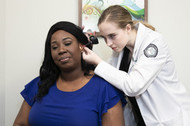Pre-Health Tracks
 Physicians examine patients, obtain medical histories, and order, perform and interpret diagnostic tests. They counsel patients about illness, injuries, health conditions, and preventive healthcare (diet/fitness, smoking cessation, etc.)
Physicians examine patients, obtain medical histories, and order, perform and interpret diagnostic tests. They counsel patients about illness, injuries, health conditions, and preventive healthcare (diet/fitness, smoking cessation, etc.) 
Anesthesiologist assistants are highly skilled professionals who work under the direction of licensed anesthesiologist and as part of anesthesia team to design and implement anesthesia care plans.

Audiologists are the primary health-care professionals who evaluate, diagnose, treat, prevent, and manage hearing loss and balance disorders in individuals of all ages from infants to teens to adults and older adults.

A cardiovascular sonographer is a cardiovascular technologist who specializes in heart imaging administrate ultrasounds that create images of the heart and surrounding circulatory organs, such as blood vessels.

Chiropractic is a health-care profession that focuses on the spine and other joints of the body, and their connection to the nervous system. A chiropractor treats disorders (such as back and neck pain) chiefly of the musculoskeletal system especially through the manual adjustment or manipulation of the spinal vertebrae to correct nervous system dysfunction.

Dentists ensure patients receive proper and professional oral health care. Examine, diagnose, and treat diseases, injuries, and malformations of teeth and gums.

A sonographer uses high frequency sound waves to create detailed images of various areas of the human anatomy.

Naturopathic medicine is a distinct primary health care profession, emphasizing prevention, treatment, and optimal health through the use of therapeutic methods and substances that encourage individuals’ inherent self-healing process.

Nursing is a profession within the health care sector focused on the care of individuals, families, and communities so they may attain, maintain, or recover optimal health and quality of life.

Occupational therapists provide services to promote and/or develop clients' meaningful engagement in their chosen occupations, through various practice approaches such as rehabilitation, prevention, consultation, and wellness promotion.

Optometrists are professionals who specialize in problems associated with the eyes and vision. They examine patients' eyes for visual issues and manage other problems or diseases that are eye-related.

Doctors of Osteopathic Medicine (D.O.s) are educated to use their minds, senses, and hands to help diagnose and treat patients. Instead of treating specific symptoms or illness, they regard the body as an integrated whole and focus on preventive care to maximize the health of each patient they treat.

The patient care pharmacist, or clinical pharmacist, is highly educated in disease process, pharmacotherapy, and patient monitoring. Pharmacists review patient history and disease manifestations to guide the selection of cost-effective therapy. Pharmacists work closely with interprofessional teams, including physicians, nurses, and other members of the health care team.

Physical Therapist also known as PT are health professionals that assist people who have been in accident or have disabling conditions such as low-back pain, arthritis, heart disease, fractions, head injuring, and cerebral palsy.

Physician assistants work in collaboration with a licensed physician to provide medical care to patients.

A Podiatrist is a Doctor of Podiatric Medicine (DPM), and is trained to diagnose and treat conditions affecting the foot, ankle and related structures of the leg.

Public health administrators promote and protects the health of the people and the communities where they live, learn, work, and play. Public health works to track disease outbreaks, prevent injuries and shed light on why some of us are more likely to suffer from poor health than others.

As defined by the American Speech-Language-Hearing Association (ASHA) a speech-language pathologist (SLP) works “to prevent, assess, diagnose, and treat speech, language, social communication, cognitive-communication, and swallowing disorders in children and adults.”

Veterinary medicine is wide, covering all animal species, both domesticated and wild, with a range of conditions that can affect different species.